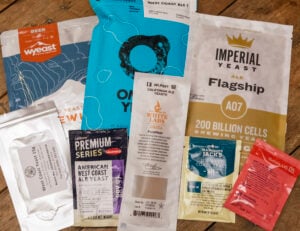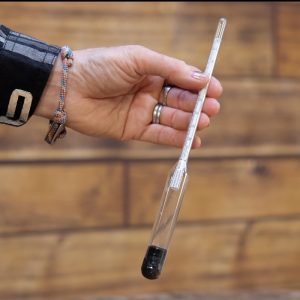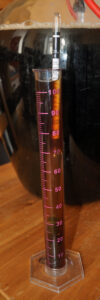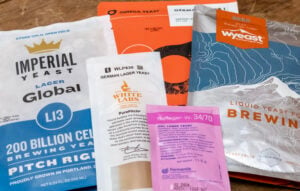Brew With Us ESSENTIALS – ale and lager yeasts

Keep it clean
The lion’s share of yeast strains available to homebrewers are ale and lager yeasts.
These strains produce “clean” flavours that work across lots of styles.
Let’s take a look!
There are hundreds of different ale and lager strains available. Some of these can be traced back to a single brewery or even a single beer. The most popular strains are available from more than one yeast lab under different names.
One strain that’s available from almost every yeast lab is “Chico”, which is nicknamed after the hometown of the Sierra Nevada Brewing Company. This strain produces clean, dry beers that are a good platform for hops. It’s currently available as:
- Wyeast 1056 “American Ale”
- White Labs WLP001 “California Ale”
- Imperial Yeast A07 “Flagship”
- Omega Yeast OYL-004 “West Coast I”
- Fermentum Mobile FM52 “American Dream”
- Gigayeast GY001 “Norcal Ale”
- Safale US-05
- Lallemand BRY-97
- Mangrove Jacks M44
- And our own NBS West Coast Ale Yeast

… well, we’re reasonably sure those are right. Yeast labs can be very secretive about the sources of their strains, as can the breweries they were sourced from – the breweries may not have given permission for their names to be associated with the yeast, or may even consider the yeast part of their intellectual property. So some names are cryptic references to the source of the yeast, and others are very generic to avoid associations, and instead tell you the style of beer best suited to the yeast.
Some other ale strains worth knowing about are:
- White Labs WLP039 “East Midlands”
- Lallemand Nottingham
- NBS Ale Yeast
Clean and neutral flavour, suitable for all dry British ales.
- Wyeast 1968 “London ESB”
- White Labs WLP002 “English Ale”
- Imperial A09 “Pub”
- Omega OYL-016 “British Ale VIII”
- Lallemand “London”
- NBS Classic Ale Yeast
Mild fruity flavour with some residual sweetness. Versatile and suitable for both British and USA-style ales.
- Wyeast 1098 “British Ale”
- White Labs WLP007 “English Dry”
- Imperial A01 “House”
- Omega OYL-006 “British Ale I”
- WHC “Bond”
- Safale S-04
Similar to “Fullers” but with a drier finish. Copes well with high gravity beers, still finishing dry.
- White Labs WLP095 “Burlington Ale”
- The Yeast Bay WLP4000 “Vermont”
- Imperial A04 “Barbarian”
- Omega OYL-052 “DIPA Ale”
- Fermentum FM55 “Green Hill”
- WHC “Sanders”
The original New England IPA strain. Can also produce great British beers because of its fruity flavour.
- Wyeast 1318 “London Ale III”
- White Labs WLP066 “London Fog”
- Imperial A38 “Juice”
- Omega OYL-011 “British Ale V”
- Lallemand “New England”
No-one knows where the “London” name comes from since Boddingtons is from Manchester!
Fruity flavour, works well in both traditional British ales and hazy New England IPAs.
The gravity of the situation
You’ll often see the initials “OG” and “FG” on a recipe. The “G” stands for “gravity” as in specific gravity, a measurement of how dense a liquid is. On this scale, 1.000 is water. Anything thicker than water (beer, blood, etc.) is higher. You can measure gravity using a hydrometer.
Wort is denser than water because of all the sugars dissolved in it, so it will have a gravity above 1.000. The Original Gravity (OG) is the gravity of your wort before fermentation and is determined by how much grain you used and how efficient your mash was at extracting sugar from the malt.
Measuring the gravity of your wort gives you an accurate view of how well fermentation is going. Alcohol is thinner than water, so the gravity of your wort will decrease as the yeast consumes the sugars in your wort and leaves alcohol behind. The Final Gravity (FG) is the gravity of your beer when fermentation has finished – usually this is a stable reading for several days in a row.
Attenuation is the name for how much sugar the yeast can eat – a high attenuating strain will eat more complex sugars, giving a lower FG compared to a low attenuating one. You don’t always want the lowest possible FG. In some styles, it’s better to have some residual sugar left over.
Yeast is generally quite predictable, so you can estimate what FG you will get based on your OG and the average attenuation for that particular strain. A good recipe will give you the expected OG and FG so you can tell how well your brew is going.


Lager time
The main difference between ale and lager yeasts is the temperature they work at. Ale yeasts are most comfortable around room temperature – typically 18-20°C. Lager yeasts will ferment at these temperatures too, but they can also tolerate much colder conditions. Classic lager strains are comfortable around 8-12°C and produce their best flavours in this range. Warmer temperatures typically produce less welcome flavours from lager strains, though not always.
“True” lager strains are actually a different species of yeast. Ale yeasts are almost all Saccharomyces cerevisiae, and “true” lager strains are S. pastorianus. This second species is a hybrid of S. cerevisiae and another Saccharomyces. However, there are lots of strains used for lagers that are S. cerevisiae, so the exact species isn’t as important as how well the strain works in beer!

One of the most popular lager strains originates from the Weihenstephan Brewing Institute in Bavaria, where it has the unassuming catalogue number “34/70”. This is an exceptionally clean strain that doesn’t produce such strong sulphur-like flavours as some other lager strains. This strain is sold as:
- Wyeast 2124 “Bohemian Lager”
- White Labs WLP830 “German Lager”
- Imperial L13 “Global”
- Omega OYL-1006 “German Lager I”
- Saflager W-34/70
Sulphur is not necessarily a bad thing in a pilsner strain: for some brewers, it is partly what distinguishes European lagers from the much cleaner styles produced in the USA and elsewhere. However, this character does need to be restrained to avoid it taking over.
- Wyeast 2001 “Pilsner Urquell H-Strain”
- White Labs WLP800 “Pilsner Lager”
- Omega OYL-101 “Pilsner I”
Classic Czech lager flavour, more sulphur than 34/70 (ageing helps to reduce sulphur levels.)
- Wyeast 2007 “Pilsen Lager”
- White Labs WLP840 “American Pilsner Lager”
- Imperial L11 “Gateway”
- Omega OYL-102 “American Pilsner”
Crisp, dry, and relatively neutral flavour.
- Wyeast 2112 “California Lager”
- White Labs WLP810 “San Francisco Lager”
- Imperial L05 “Cablecar”
- Omega OYL-105 “West Coast Lager”
- Mangrove Jacks M54
Unusually, prefers warmer temperatures but still produces a lager-like profile.
- Wyeast 2206 “Bavarian Lager”
- White Labs WLP820 “Oktoberfest Lager”
- Imperial L02 “Fest”
- Omega OYL-107 “Oktoberfest”
- Saflager S23
Finishes with residual sweetness that accentuates malty flavours.
The secret to good fermentation…
… isn’t really a secret. It’s healthy yeast!
Our next chapter is full of top tips to keep your yeast in top condition ready for fermentation.


